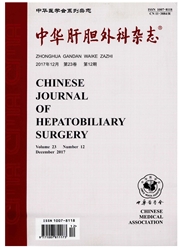

 中文摘要:
中文摘要:
目的对抗肿瘤药的天然耐药和化疗过程中产生的继发性耐药是肝癌化疗敏感性差的重要原因之一,为探讨体外逆转肝癌多药耐药(multidrug resistance,MDR)的新方法,笔者建立了单因素人肝癌细胞多药耐药模型HepG2/mrp1,并研究其生物学特性。方法双酶切克隆质粒pGEM—mrp1获得人全长多药耐药相关蛋白基因(mrp1),并将其插入哺乳动物表达载体pCI—neo的多克隆位点,构建重组载体,利用质脂体法将重组载体转人人肝癌细胞HepG2,建立单基因耐药细胞株HepG2/mrp1。观察细胞的生长规律;MTT法检测其多药耐药性;流式细胞仪检测细胞表面多药耐药相关蛋白(multidrug resistance-associated protein,MRP)的表达;RT—PCR检测MRP1 tuRNA表达量。结果与HepG2细胞相比较,HepG2/mrp1细胞的倍增时间延长30.86h。该细胞对多种抗肿瘤药耐药,HepG2/mrp1对阿霉素和柔红霉素的耐药指数比亲本细胞增加了11.4倍和8倍,细胞表面MRP1的表达明显增加,mrp1 tuRNA明显增加。结论HepG2/mrp1细胞稳定高表达MRP1,具有多药耐药性,为进一步研究肝癌的多药耐药构建了一个技术平台。
 英文摘要:
英文摘要:
Objective Treatment of hepatoeellular carcinoma(HCC) is hampered by resistance to chemotherapy, which might be mediated by multidrug resistance-associated proteins(MRP). The recombinant mammalian expression vector(pCI-neo) carrying human full lengh MRP cDNA was constructed and transfected into human hepatocellular carcinoma cell line HepG2. The transfergene multidrug resistant cell line(HepG2/mrp1) was established. Methods The human full-length MRP eDNA was obtained from cloning vector pGEM-mrp1, which was cloned into pCI-neo multiple cloning site and the recombinant expression vector(pCI-mrp1) was constructed, which transfected into HepG2 and established the multidrug resistant cell line HepG2/mrp1. The ehemosensitivity of HepG2/mrp1 was determined by MTT assay. The intracellular concentration of DNR and MRP was determined by flow cytometry. The MRP mRNA was assessed with reverse transcriptase polymerase chain reaction(RT- PCR). Results The resistance index of ADM and DNR was 11.4 and 8 times in HepG2/mrp1 cell line, higher than that of parent cell line HepG2. The MRP and MRP mRNA positive expression in- creased and the introcellular concentration of DNR decreased compared with parent cell line HepG2 respectively. Conclusion Hepatoeareinoma cell line HepG2/mrp1 transfeeted MRP eDNA with stably over-expressed MRP presents typical MDR phenotype. It provides a good model for the study of MRP mediated MDR.
 同期刊论文项目
同期刊论文项目
 同项目期刊论文
同项目期刊论文
 期刊信息
期刊信息
